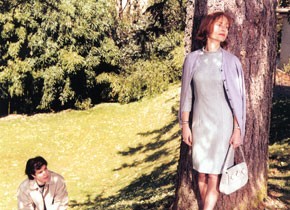Claude Chabrol
April 1 to 30, 2006
Of the principal directors of the French New Wave, Claude Chabrol has established himself as the great auteur in genre cinema. A large part of his oeuvre consists of crime dramas which, with extraordinary yet unobtrusive formal refinement and ironic ambivalence, plumb the depths of the bourgeoisie. This has led to his reputation as being primarily a social critic; however, his second major motivation is cinema itself and the pleasure of playing with the medium.
Born in Paris in 1930, he grew up in the country during the years of the German occupation; after the War, he returned to the capital, where he quickly joined the circle of critics and budding directors in the Cahiers du cinéma crowd. In 1957, he and Eric Rohmer published a pioneering study of Hitchcock, a filmmaker whose ideas (in addition to those of Lang, Murnau and Lubitsch) he was to expand upon in his own films. Thanks to an inheritance, he was able to shoot the first rough-edged feature film of the New Wave in 1958: Le Beau Serge. The film's success allowed him to adopt a work method of constant production, a fact which is essential to bear in mind in order to understand his complete oeuvre. This steady output produced results of varying success while covering a wide diversity of genres. The sheer contagious joy of filmmaking provides the drive for Chabrol's artistic creation; as the financier (for the débuts of Rohmer and Rivette) and as a technical consultant (for Jean-Luc Godard's first film), he also played the role of "midwife" for the New Wave.
In his early masterpiece Les Bonnes Femmes (1960), he offered an unsentimental, compassionate glimpse into the lives of Parisian shopgirls with all their hopes and social constraints. Both in the wealth of its formal imagination and in the superb directing of the cast, and even more so in its openness and power to affect the viewer, this study of everyday life is the first centrepiece in the total Chabrol picture.
The works of his most famous period from 1968 to 1974 – consisting of a series of brilliant crime films, whose idiom he defined with La Femme infidèle and which he intensified in principal works like Le Boucher and La Rupture – are marked by the same kind of ambivalence. In these films, Chabrol examines the moral corruption, ignorance and tragic-comic self-delusions of the upper middle class with the fascinated curiosity of an entomologist. Here and elsewhere in Chabrol's works, the family plays a key role: it is the original cell of the social system and the guarantee for its continued existence.
With a selection of more than 20 films, the Film Museum will show Chabrol’s major works alongside some "atypical" and long-neglected examples from his oeuvre. These include the dark comedy L'Oeil du malin (1961) and the fascinating film about his screenwriter’s marriage crisis, Une partie du plaisir (1975). His adaptations of historic crime cases like Violette Nozière (1978) and Une affaire de femmes (1988) are also represented, as is a pronounced tribute to the most recent pinnacles in his oeuvre: from the masterpiece La Cérémonie (1995) to the Austrian premiere of his new film, fresh from its première in Berlin, L'Ivresse du pouvoir. The last four films cited above are marked by Isabelle Huppert playing the leading roles. Her stylistic diversity and her delight in acting make her the perfect partner for Chabrol's late, classicist phase: they both go about their work with equal portions of serenity, seriousness and nonchalance.


